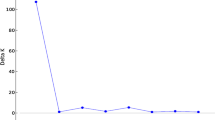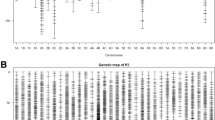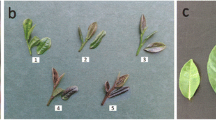Abstract
As the second most consumed non-alcoholic beverage, the tea plant (Camellia sinensis) has high economic value. Tea improvement efforts that largely target economic traits such as yield have traditionally relied on conventional breeding approaches. The tea plant’s perennial nature and its long generation time make conventional approaches time-consuming and labour-intensive. Biotechnology provides a complementary tool for accelerating tea improvement programmes through marker-assisted selection (MAS). Quantitative trait loci (QTLs) identified on linkage maps are an essential prerequisite to the implementation of MAS. QTL analysis was performed on yield data over 3 years (2010–2012) across two sites (Timbilil and Kangaita, in Kenya), based on two parental framework linkage maps arising from a population of 261 F1 progeny, derived from a reciprocal cross between GW Ejulu and TRFK 303/577. The maps contain 15 linkage groups each, this corresponds to the haploid chromosome number of tea (2n=2x=30). The total length of the parental maps was 1028.1 cM for GW Ejulu and 1026.6 cM for TRFK 303/577 with an average locus spacing of 5.5 cM and 5.4 cM, respectively. A total of 13 QTLs were identified over the three measurement years. The 13 QTLs had LOD values ranging from 1.98 to 7.24 and explained 3.4% to 12% of the phenotypic variation. The two sites had seven mutually detected QTLs.




Similar content being viewed by others
References
Anon (2002) Tea growers handbook, 5th edn. Tea Research Foundation of Kenya, Kericho, p 261
Bali S, Mamgain A, Raina SN, Yadava SK, Bhat V, Das S, Pradhan AK, Goel S (2015) Construction of a genetic linkage map and mapping of drought tolerance trait in Indian beveragial tea. Mol Breed 35(5):1–20
Chang Y, Oh EU, Lee MS, Kim HB, Moon DG, Song KJ (2017) Construction of a genetic linkage map based on RAPD, AFLP, and SSR markers for tea plant (Camellia sinensis). Euphytica 213(8):190
Chen JD, Zheng C, Ma JQ, Jiang CK, Ercisli S, Yao MZ, Chen L (2020) The chromosome-scale genome reveals the evolution and diversification after the recent tetraploidization event in tea plant. Hort Res 7(1):1–1
Collard BC, Mackill DJ (2008) Marker-assisted selection: an approach for precision plant breeding in the twenty-first century. Philos Trans R Soc Lond B Biol 363(1491):557–572
Doerge RW (2002) Mapping and analysis of quantitative trait loci in experimental populations. Nat Rev Genet 3(1):43–52
Dracatos PM, Haghdoust R, Singh RP, Huerta Espino J, Barnes CW, Forrest K, Hayden M, Niks RE, Park RF, Singh D (2019) High-density mapping of triple rust resistance in barley using DArT-seq markers. Front Plant Sci 10:467
OECD/FAO (2020) OECD-FAO Agricultural Outlook 2020-2029, FAO, Rome/OECD Publishing, Paris. https://doi.org/10.1787/1112c23b-en
FAOSTAT (2018) Food and Agriculture Organisation of the United Nations. Statistical database. FAO, Rome. http://www.fao.org
Gawel NJ, Jarret RL (1991) A modified CTAB DNA extraction procedure for Musa and Ipomoea. Plant Mol Biol Rep 9(3):262–6
George AW, Visscher PM, Haley CS (2000) Mapping quantitative trait loci in complex pedigrees: a two-step variance component approach. Genetics 156(4):2081–2092
Grattapaglia D, Sederoff R (1994) Genetic linkage maps of Eucalyptus grandis and Eucalyptus urophylla using a pseudo-testcross: mapping strategy and RAPD markers. Genetics 137(4):1121–1137
Hackett CA, Wachira FN, Paul S, Powell W, Waugh R (2000) Construction of a genetic linkage map for Camellia sinensis (tea). Heredity 85:346–355
Hu Z, Reecy JM, Wu X (2012) Design database for quantitative trait loci (QTL) data warehouse, data mining, and meta-analysis. In: Rifkin SA (ed) Quantitative trait loci (QTL) methods and protocols. Humana Press, San Diego, pp 121–144
Huang J, Li J, Huang Y, Luo J, Gong Z, Liu Z (2005) Construction of AFLP molecular markers linkage map in tea plant. J Tea Sci 25:7–15
Kamunya SM, Wachira FN, Pathak RS, Korir R, Sharma V, Kumar R, Bhardwaj P, Muoki RC, Ahuja PS, Sharma RK (2010) Genomic mapping and testing for quantitative trait loci in tea (Camellia sinensis (L.) O. Kuntze). Tree Genet Genomes 6(6):915–929
Kearsey MJ, Pooni HS (1996) The genetical analysis of quantitative traits. Stanley Thorne, Cheltenham, p 381
Kenya National Bureau of Statistics (2012) Kenya facts and figures 2012
Khan N, Mukhtar H (2007) Tea polyphenols for health promotion. Life Sci 81(7):519–533
Koech RK, Malebe PM, Nyarukowa C, Mose R, Kamunya SM, Apostolides Z (2018) Identification of novel QTL for black tea quality traits and drought tolerance in tea plants (Camellia sinensis). Tree Genet Genomes 14(1):9
Koech RK, Malebe PM, Nyarukowa C, Mose R, Kamunya SM, Joubert F, Apostolides Z (2019) Functional annotation of putative QTL associated with black tea quality and drought tolerance traits. Sci Rep 9(1):1465
Koech RK, Malebe PM, Nyarukowa C, Mose R, Kamunya SM, Loots T, Apostolides Z (2020) Genome-enabled prediction models for black tea (Camellia sinensis) quality and drought tolerance traits. Plant Breed 00:1–13
Kullan ARK, Van Dyk MM, Jones N, Kanzler A, Bayley A, Myburg AA (2012) High-density genetic linkage maps with over 2,400 sequence-anchored DArT markers for genetic dissection in an F2 pseudo-backcross of Eucalyptus grandis× E. urophylla. Tree Genet Genomes 8:163–175
Ma JQ, Yao MZ, Ma CL, Wang XC, Jin JQ, Wang XM, Chen L (2014) Construction of a SSR-based genetic map and identification of QTLs for catechin content in tea plant (Camellia sinensis). PLoS One 9(3):e93131. https://doi.org/10.1371/journal.pone.0093131
Malebe MP, Mphangwe NI, Myburg AA, Apostolides Z (2019) Assessment of genome-wide DArT-seq markers for tea Camellia sinensis (L.) O. Kuntze germplasm analysis. Tree Genet Genomes 15(4):1–9
Mondal TK, Bhattacharya A, Laxmikumaran M, Ahuja PS (2004) Recent advances of tea (Camellia sinensis) biotechnology. Plant Cell Tiss Org 76:195–254
Nadeem MA, Karaköy T, Yeken MZ, Habyarimana E, Hatipoğlu R, Çiftçi V, Nawaz MA, Sönmez F, Shahid MQ, Yang SH, Chung G (2020) Phenotypic characterization of 183 Turkish common bean accessions for agronomic, trading, and consumer-preferred plant characteristics for breeding purposes. Agron 10(2):272
Pettigrew J, Richardson B (2014) A social history of tea: tea’s influence on commerce, culture & community. Benjamin Press, New Port Richey
Sansaloni C, Petroli C, Jaccoud D, Carling J, Detering F, Grattapaglia D, Kilian A (2011) Diversity Arrays Technology (DArT) and next-generation sequencing combined: genome-wide, high throughput, highly informative genotyping for molecular breeding of Eucalyptus. BMC Proc 5(7):P54
Tan LQ, Wang LY, Xu LY, Wu LY, Peng M, Zhang CC, Wei K, Bai PX, Li HL, Cheng H, Qi GN (2016) SSR-based genetic mapping and QTL analysis for timing of spring bud flush, young shoot color, and mature leaf size in tea plant (Camellia sinensis). Tree Genet Genomes 12(3):52
Taniguchi F, Furukawa K, Ota-Metoku S, Yamaguchi N, Ujihara T, Kono I, Fukuoka H, Tanaka J (2012) Construction of a high-density reference linkage map of tea (Camellia sinensis). Breed Sci 62:263–273
Taylerson K (2012) The health benefits of tea varieties from Camellia sinensis. The Plymouth Stud Sci 5(1):304–312
Tea Research Institute (TRI) (2017). Annual technical report. Kenya agricultural & livestock research organization (KALRO) pp 1–50
Van OoiJen JW (2006) JoinMap ® 4, software for the calculation of genetic linkage maps in experimental populations. Kyazma BV, Wageningen, Netherlands
Van Ooijen J, Kyazma B (2009) MapQTL 6. Software for the mapping of quantitative trait loci in experimental populations of diploid species. Kyazma BV, Wageningen
Voorrips RE (2002) MapChart: software for the graphical presentation of linkage maps and QTLs. J Hered 93:77–78
Wei C, Yang H, Wang S, Zhao J, Liu C, Gao L, Xia E, Lu Y, Tai Y, She G, Sun J (2018) Draft genome sequence of Camellia sinensis var. sinensis provides insights into the evolution of the tea genome and tea quality. PNAS 1;115(18): E4151–8
Xia E, Zhang H, Sheng J, Li K, Zhang Q, Kim C, Zhang Y, Liu Y, Zhu T, Li W (2017) The tea tree genome provides insights into tea flavor and independent evolution of caffeine biosynthesis. Mol Plant 10(5):866–877
Xia E, Tong W, Hou Y, An Y, Chen L, Wu Q, Liu Y, Yu J, Li F, Li R, Li P (2020) The reference genome of tea plant and resequencing of 81 diverse accessions provide insights into genome evolution and adaptation of tea plants. Mol Plant 13:1013–1026
Xu L, Wang L, Wei K, Tan L, Su J, Cheng H (2018) High-density SNP linkage map construction and QTL mapping for flavonoid-related traits in a tea plant (Camellia sinensis) using 2b-RAD sequencing. BMC Genomics 19:955
Acknowledgements
The authors thank the staff of Crop Improvement and Management, Tea Research Institute, who assisted in phenotypic data collection and extraction of DNA from the mapping population. We acknowledge Mr. Richard Mose for his critical reading and feedback on this manuscript.
The first author acknowledges the financial assistance of the Carnegie Regional Initiative in Science and Education (Carnegie-RISE) through the Southern African Biochemistry and Informatics for Natural Products (SABINA) network. The financial assistance of the National Research Foundation (NRF) towards this research is hereby acknowledged by the first author. Opinions expressed and conclusions arrived at are those of the authors and are not necessarily to be attributed to the NRF, Carnegie-RISE or SABINA.
Data archiving
The DArT sequences have been submitted to NCBI: BioProject PRJNA398959 (Suppl. Table 4) https://www.ncbi.nlm.nih.gov/biosample?LinkName=bioproject_biosample_all&from_uid=39895.
Author information
Authors and Affiliations
Corresponding author
Ethics declarations
Conflict of interest
The authors declare that they have no conflict of interest.
Additional information
Communicated by D. Chagné
Publisher’s note
Springer Nature remains neutral with regard to jurisdictional claims in published maps and institutional affiliations.
Supplementary information
ESM 1
(DOCX 1315 kb)
Rights and permissions
About this article
Cite this article
Malebe, M.P., Koech, R.K., Mbanjo, E.G.N. et al. Construction of a DArT-seq marker–based genetic linkage map and identification of QTLs for yield in tea (Camellia sinensis (L.) O. Kuntze). Tree Genetics & Genomes 17, 9 (2021). https://doi.org/10.1007/s11295-021-01491-1
Received:
Revised:
Accepted:
Published:
DOI: https://doi.org/10.1007/s11295-021-01491-1




